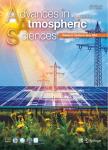Impact of Drought on Agriculture in the Indo-Gangetic Plain,India
Impact of Drought on Agriculture in the Indo-Gangetic Plain,India作者机构:Center for Monsoon System ResearchInstitute of Atmospheric PhysicsChinese Academy of SciencesBeijing 100029China School of System SciencesBeijing Normal UniversityBeijing 100875China Key Laboratory of Middle Atmosphere and Global Environmental ObservationsInstitute of Atmospheric PhysicsChinese Academy of SciencesBeijing 100029China Meteorology and Climate UnitSchool of Mathematical ScienceUniversity College DublinDublin 4Ireland
出 版 物:《Advances in Atmospheric Sciences》 (大气科学进展(英文版))
年 卷 期:2017年第34卷第3期
页 面:335-346页
核心收录:
基 金:supported by the National Basic Research Development Program of China(Grant No.2015CB953602) National Science Foundation of China(Grant Nos.41271542 and 41661144006) a CAS-TWAS President’s Fellowship,2013
主 题:drought agriculture SPEI Indo-Gangetic Plain temperature precipitation potential evapotranspiration
摘 要:In this study, we investigate the spatiotemporal characteristics of drought in India and its impact on agriculture during the summer season (April-September). In the analysis, we use Standardized Precipitation Evapotranspiration Index (SPEI) datasets between 1982 and 2012 at the six-monthly timescale. Based on the criterion SPEI 〈 -1, we obtain a map of the number of occurrences of drought and find that the humid subtropical Upper Middle Gangetic Plain (UMGP) region is highly drought-prone, with an occurrence frequency of 40%-45%. This UMGP region contributes at least 18%-20% of India's annual cereal production. Not only the probability of drought, but the UMGP region has become increasingly drought-prone in recent decades. Moreover, cereal production in the UMGP region has experienced a gradual declining trend from 2000 onwards, which is consistent with the increase in drought-affected areas from 20%-25% to 50%-60%, before and after 2000, respectively. A higher correlation coefficient (-0.69) between the cereal production changes and drought-affected areas confirms that at least 50% of the agricultural (cereal) losses are associated with drought. While analyzing the individual impact of precipitation and surface temperature on SPEI at 6 month timescale [SPEI (6)] we find that, in the UMGP region, surface temperature plays the primary role in the lowering of the SPEI. The linkage is further confirmed by correlation analysis between SPEI (6) and surface temperature, which exhibits strong negative values in the UMGP region. Higher temperatures may have caused more evaporation and drying, which therefore increased the area affected by drought in recent decades.



